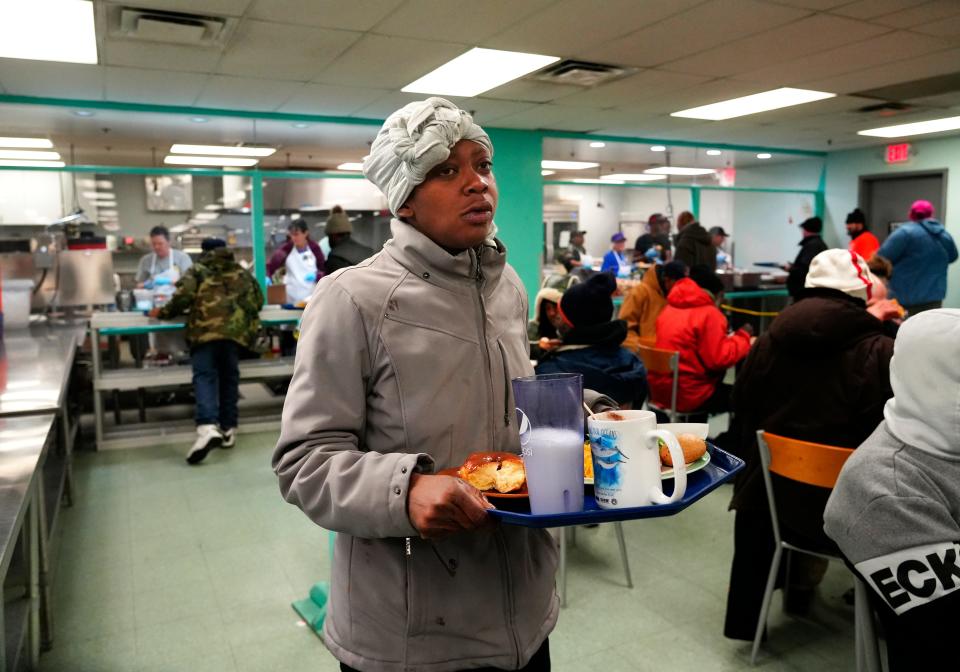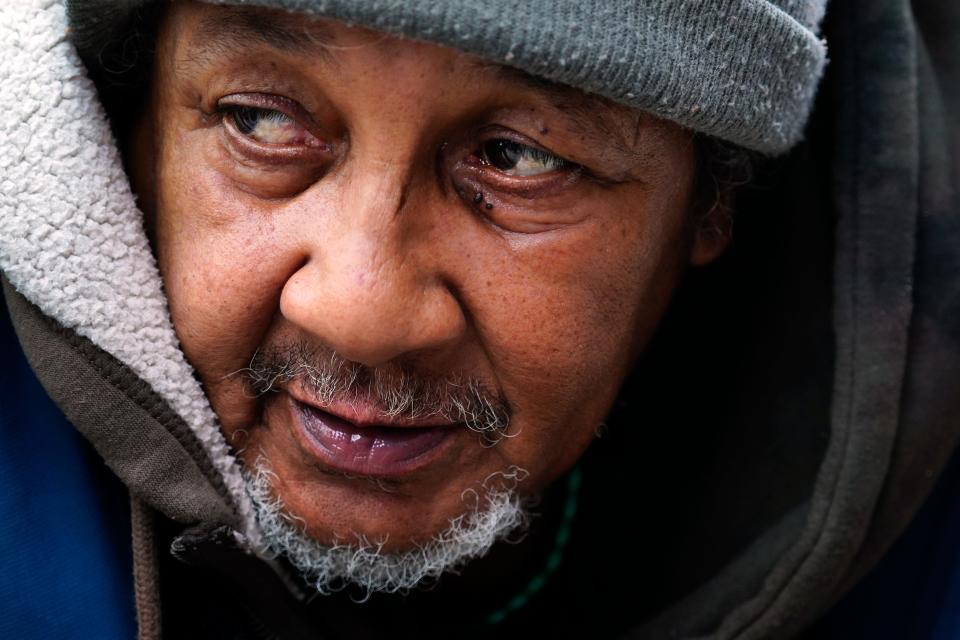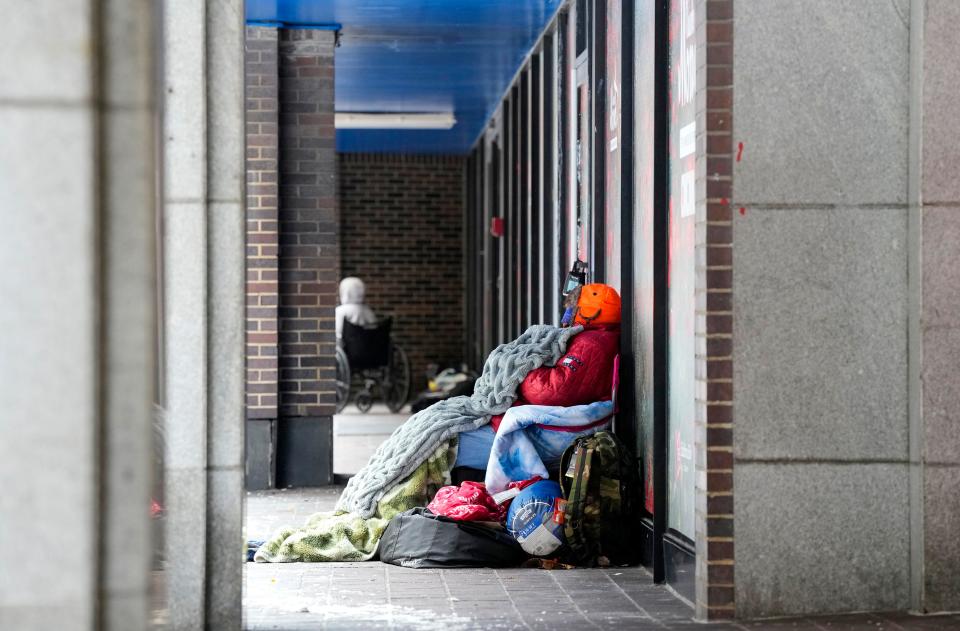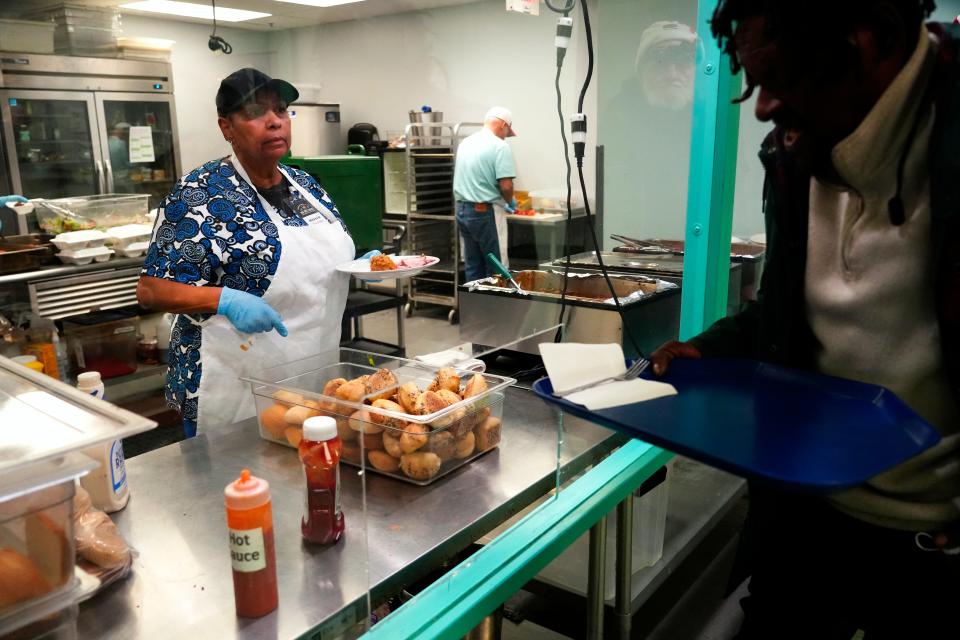Homeless report: More people sleeping outside in Cincinnati than in almost a decade
Tables at Our Daily Bread soup kitchen in Over-the-Rhine were packed as usual on Jan. 31, and more hungry visitors stood in the cafeteria line waiting for a hot meal. The floor of a smaller, side room was full too. These guests, some wrapped in coats and hats, napped on yoga mats in the warmth after a night outside.

Fatima Phelps, 31, slid into an open seat with a tray of food. She has been chronically homeless for about five years. She lost her Social Security card, ID and birth certificate while sleeping on East 13th Street one night.
“Sometimes I’m outside,” Phelps said. "There’s a lot of people out there every night.”
She's right – more than the city has experienced in nearly a decade.
Homeless people sleeping outside jumps by nearly half
The number of homeless people sleeping outside in the Cincinnati area rose by nearly half in 2023 from 2022 – from 752 to 1,100, a new report shows. It is a count not seen since 2015.
Local data released this month and collected by outreach workers in 2023 for the U.S. Department of Housing and Urban Development shows the jump and more details about the city’s homeless people.
There was a 46% surge in people sleeping outside, said Kevin Finn, president and CEO of Strategies to End Homelessness. The organization administers government funding and heads up the system by which agencies collect data on the region’s homeless population in the Cincinnati and Hamilton County region.
The Greater Cincinnati Coalition for the Homeless, a social action agency connecting services for people who are homeless throughout the region, is also reporting an unrelenting need for help.
"As more people experience homelessness, if they cannot be accommodated in shelters, then they will end up outside on the streets,” Finn said, “where they are three times as likely to die.”
Is a lack of enough affordable housing at fault?
A lot of people can’t afford to rent in Cincinnati, say advocates for those who do not have a home.
The homeless data in 2023 reflect that problem, said Josh Spring, executive director of the homeless coalition.
“We are experiencing the largest increase in people forced to live outdoors in at least a decade,” he said. “Ending homelessness will take more than surface-level commitment. It will take bold, sustainable investment as a city in truly affordable housing.”
Cincinnati has a high percentage of renters – about 60% of the metro area’s residents, according to 2019 U.S. Census data, and almost half are considered burdened renters because they spend at least 30% of their income on housing.
Mayor Aftab Pureval, in a statement, highlighted several reforms and interventions intended to making housing more afforable, including funding emergency rental assistance and awarding grants to a coalition of organizations to identify and address the causes of homelessness.
"But it’s undeniable that we have a long way to go – and it’s going to require system-level reforms," he said.

Allen Gray said he was evicted in 2021 and has been sleeping on Cincinnati-area streets routinely since then.
Gray, 64, said he and a roommate found a note taped to the front door of their Downtown rental in September that year ordering them to vacate within 30 days. He said the pair had been paying the $700 per month rent, but the place needed a lot of repairs.
“We just got out on the street,” he said. And while he goes to a shelter once in a while, generally, he said, he’s been sleeping outside.
“Last year it was so cold,” Gray said, “I barely made it through.”
Leaning on a cart he pushes that holds his belongings, Gray said he’s hopeful now, because he got a voucher for the Cincinnati Metropolitan Housing Authority’s Housing Choice voucher program, which helps low- to moderate-income people pay rental costs.
But that system also takes time.
Each person or family has 90 days to find a unit, and that's not always easy for people to do. "It really depends on where the family looks for a place to live, their preferred unit type, and what means they have to go out and do a search," said housing authority spokeswoman Lesley Wardlow. The authority has a program that helps voucher holders and landlords connect.

Number of people experiencing homelessness rises by 2%, but service providers see overall jump
The overall homeless count in the Cincinnati area, including people who were in shelters and safe havens, increased about 2% in 2023 from the previous year, according to the report from Strategies to End Homelessness. The numbers gathered by outreach workers went from 6,038 in 2022 to 6,142 in 2023.
The data over a decade show an overall decline, from 7,306 people homeless in 2013 to 2023's 6,142, the report shows.
But needs of those who report being homeless are growing, say social service providers who help Cincinnati’s homeless people every day. They are seeing more people, too.
The advocates for homeless people attribute part of the problem to the end of COVID-19 related safety-net programs that helped people stay off the streets. The National Alliance to Prevent Homelessness reported a jump in people living without permanent housing in December 2023, pointing to the U.S. Housing and Urban Development's homeless assessment "point-in-time" homeless report for the year and suggesting that the scaling back of COVID-19 relief funds is pushing the numbers.
Hot meals, shelter resources in greater demand
Locally, people who lead efforts to help those without housing say they are seeing a significant rise in need.
Shelterhouse, which operates the largest shelters in the city for single women, single men and the emergency winter shelter, is seeing consistently high numbers of guests, said Executive Director Arlene Nolan.
“When the weather is really severe, they come in and reach out to places like us,” Nolan said. “This year we’ve seen a really sharp increase in people coming to the winter shelter (in Queensgate). Last year versus this year, we had 12% more people coming in in January alone."

Our Daily Bread served nearly 170,000 hot meals in 2023, compared with about 118,500 in 2019, before the COVID-19 pandemic hit, its records show.
The guests at the largest soup kitchen in Hamilton County self-report their living experiences, said Executive Director Georgine Getty. In 2023, 70% said they were experiencing homelessness compared to 56% in 2019. And, of those who said they were living homeless, 40% reported being unsheltered, living in camps, cars or other unsafe places, Getty said.
The service opened its extra room in February 2023, she said. "We thought it would be a game room for cards and chess, but everyone coming in was just falling asleep on the floor, so we got yoga mats and turned it into a dedicated nap room."
Maurice Malcolm was there one recent morning. He said he came to Cincinnati in February 2023, after experiencing homelessness in his home city, Cleveland.
"I'm trying to get sober," he said.
"I'm sleeping outside, anywhere," Malcolm said. "There's a lot of people – adults.
"It's hard to get comfortable," he said. "It's cold."
This article originally appeared on Cincinnati Enquirer: Cincinnati sees jump in homeless sleeping outside, food, shelter needs

